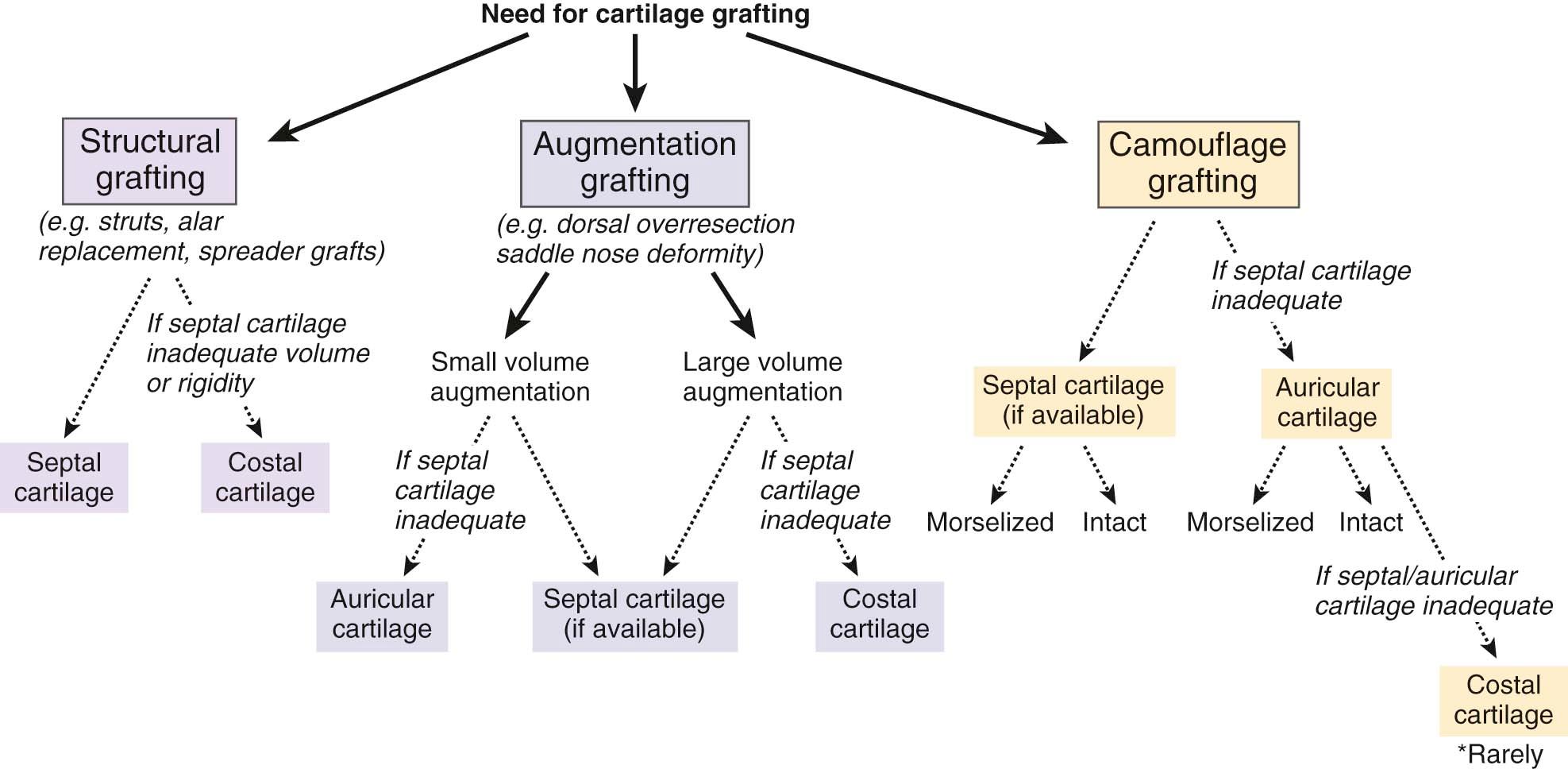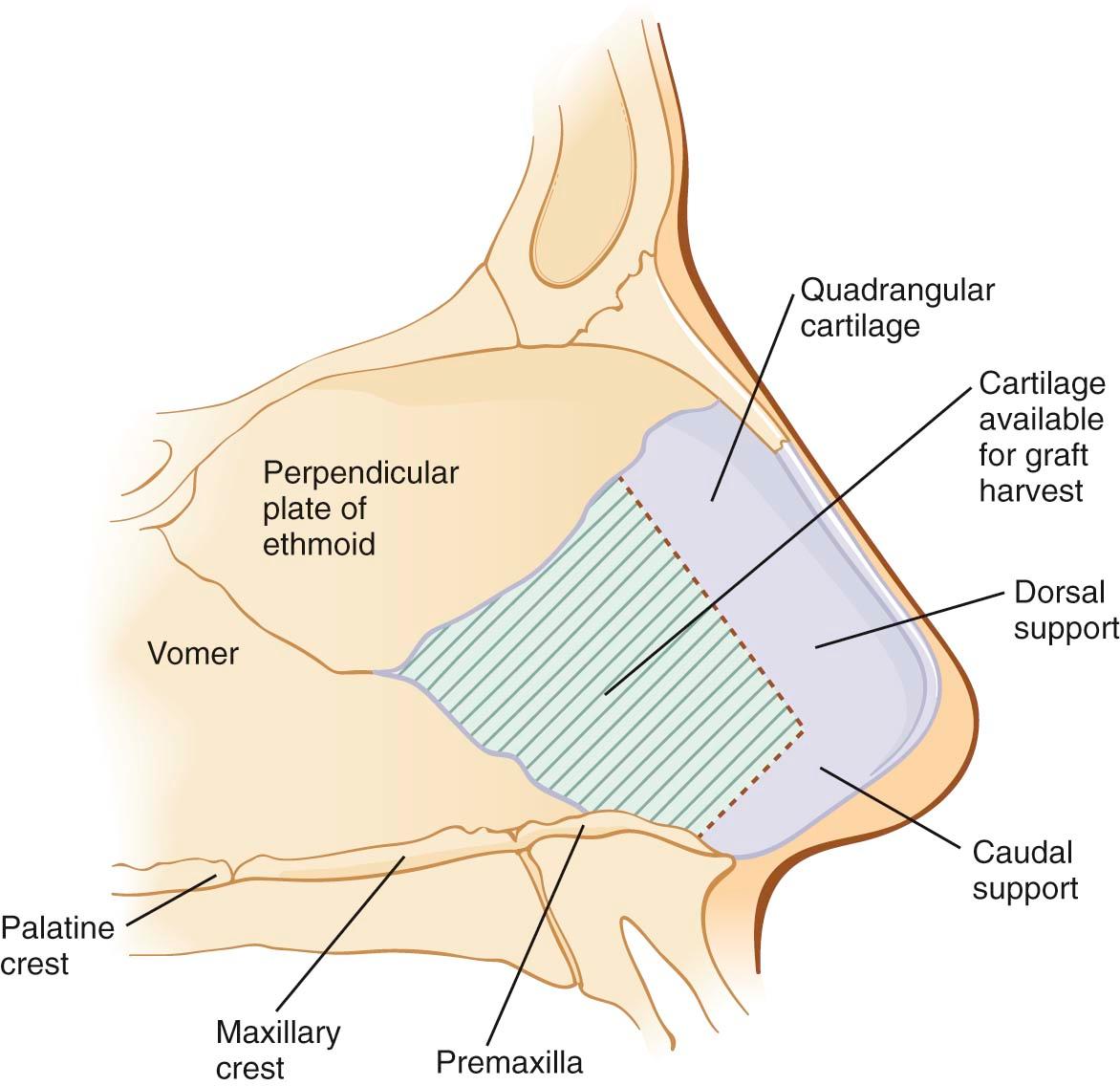Physical Address
304 North Cardinal St.
Dorchester Center, MA 02124
Maintaining or achieving structural integrity of the nasal form is a formidable task in rhinoplasty and nasal reconstruction. Maintaining the form and function of the nose is an equally important objective as creating a pleasing aesthetic contour. In this regard, numerous autograft, allograft, and synthetic materials have been proposed as the ideal replacement or augmentation matrix in nasal surgery. Despite trials of use of various synthetics such as Mersilene polyester fiber mesh, expanded polytetrafluoroethylene, porous high-density polyethylene, and numerous others, cartilage grafting remains the most reliable technique in providing nasal support, replacement of structural components of the nose, and augmentation for a variety of reasons.
Because cartilage is a normal component of the native nasal structure, it is logical to use it to replace deficiencies and create structural, contour, and aesthetic enhancements. Cartilage grafts are equally suited for structural support of the nose as well as nonsupporting applications such as camouflage grafts. Grafts can be of variable rigidity based on site of harvest and how they are modified prior to use. A whole spectrum of graft strength, thickness, volume, and malleability can be achieved by use of septal grafts, auricular grafts, costal cartilage grafts, or combinations. Thick or rigid grafts are best suited for supporting applications. Thin grafts are useful when minimal visibility is desired as in areas of thin skin over the nasal dorsum or in revision cases. Stacked and sutured grafts can help create greater support or can be used in augmentation cases when significant augmentation is required. Morselized cartilage grafts can be applied in a camouflaging fashion and will tend to “drape” more smoothly over existing structures. Diced or crushed cartilage can be used as plumping grafts along the nasolabial junction or wrapped with Surgicel, acellular dermis or temporalis fascia to augment the dorsum. Cartilage grafts can be modified to address the patient's particular need, whereas allografts are either solid and noncompressible or soft and nonsupportive. An additional benefit in using cartilage grafts is the ability to suture fixate the grafts, thereby creating less movement and a tendency for more rapid integration and vascularization.
As with any ideal implant, autologous cartilage is biocompatible and in its native state has a relatively minimal metabolic requirement allowing rapid integration. In addition, autologous cartilage is an ideal choice for compromised tissue vascularity as commonly seen in traumatic nasal deformity, revision rhinoplasty, and patients with collagen vascular disorders and diabetes.
A further advantage of use of cartilage grafting is the almost unlimited donor source such as septum, ear, and costal cartilage. Nasal septal grafts are the easiest to obtain in primary rhinoplasty or in secondary cases if the septum was not previously harvested. Auricular cartilage from one or both ears provides grafts of various shapes and sizes often suitable for camouflaging or low-volume augmentation grafting. Costal cartilage provides large volumes of material that can be carved and shaped into numerous grafting applications. Fortunately, donor site morbidity is quite minimal in harvesting cartilage from each of these sources. Donor sites for cartilage can be easily camouflaged. Septal grafts are harvested via an intranasal incision, auricular cartilage grafts can be approached through the post auricular sulcus or a well-concealed anterior incision, and costal cartilage can be obtained via an inframammary crease incision.
Multiple uses of cartilage grafts have been well described. In general, it is helpful to define the purpose of the intended grafts. In so doing, the appropriate volume of graft material of adequate strength and rigidity can be harvested for the desired application. Areas suitable for augmentation grafts are the nasofrontal recess, dorsum, nasal tip, and columella. Replacement grafts are common along the lateral crura of the lower lateral cartilages and along the caudal margin of the upper lateral cartilages. Structural grafts are commonly used in the columella in the form of struts between the medial crura and in extended tip graft configuration. Functional applications include alar replacement grafts, lateral crural strut grafts, batten grafts, spreader grafts, and alar rim supporting grafts.
Several sources of grafting cartilage are readily available for these applications. The decision regarding the source to be used is based on a number of variables including the presence or absence of donor cartilage related to prior surgery, volume of cartilage required, structural support requirements, desired contour of the grafted cartilage, graft rigidity, and donor site morbidity ( Figure 11-1 ).

When an adequate supply is available, the most desirable source of cartilage grafts is the nasal septum. As septoplasty is almost always performed concomitantly with rhinoplasty, there is no additional cartilage harvest morbidity. If used for nasal reconstructive purposes, the cartilage is within the field of reconstruction and easily accessible. Quadrangular cartilage tends to be flat and adequately rigid for structural support and can be scored, morselized, diced, or crushed if softer applications are desired. Grafts of various thicknesses can be harvested based on the grafting requirements.
Septal cartilage is most commonly harvested through a hemitransfixion or full transfixion incision as in a standard septoplasty. In external rhinoplasty, the cartilage can be harvested using an endonasal approach or from above through the medial crura. If there is a need for separation of the upper lateral cartilage from the dorsal septum, harvest from above is preferred. If the junction of the upper lateral cartilages with the dorsal septum is to remain intact, endonasal harvest is less destabilizing and requires less soft tissue dissection. Flap elevation is facilitated by hydrodissecting the submucoperichondrial plane with local anesthesia (1% lidocaine with 1 : 100,000 epinephrine, 27-gauge  -inch needle). Adequate dorsal and caudal septa (1.5 to 2.0 cm) must be preserved to prevent nasal collapse. If the amount of cartilage seems inadequate, it is better to seek an additional source rather than compromise nasal support ( Figure 11-2 ).
-inch needle). Adequate dorsal and caudal septa (1.5 to 2.0 cm) must be preserved to prevent nasal collapse. If the amount of cartilage seems inadequate, it is better to seek an additional source rather than compromise nasal support ( Figure 11-2 ).

Complications of septal cartilage harvest include compromise of dorsal or caudal support if adequate struts are not maintained, septal hematoma, septal perforation, and intranasal synechiae if raw mucosal surfaces are left in contact postoperative. Careful dissection of flaps, particularly in secondary cases, maintenance of adequate dorsal and caudal support, quilting sutures of 4-0 plain gut, and/or use of Silastic septal splints helps minimize these risks.
Disadvantages of septal cartilage are generally related to inadequate supply. Inadequate amount of cartilage may be harvested depending on the volume of cartilage required in primary rhinoplasty and the amount that can be safely removed without compromising the nasal support structure. The deficiency in septal cartilage is even greater in secondary procedures where the septum has been treated previously and there is an even greater need for rigidly supporting grafts. Some patients have anatomically inadequate available cartilage even if the septum has not been previously addressed. For instance, mesorrhine or platyrrhine noses more frequently present with larger than normal ratio of bony to cartilaginous septum. Thinner than average cartilage will also provide inadequate support in primary or secondary applications.
Become a Clinical Tree membership for Full access and enjoy Unlimited articles
If you are a member. Log in here